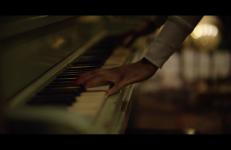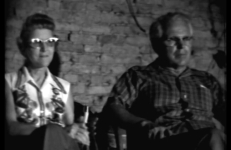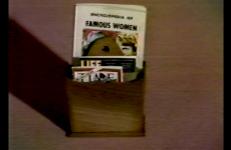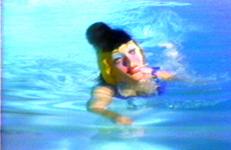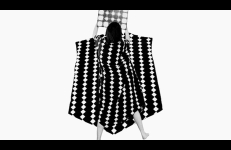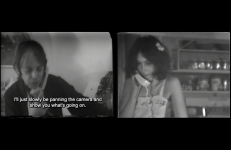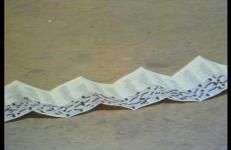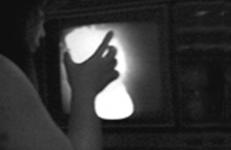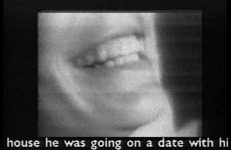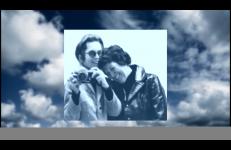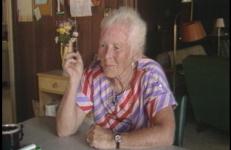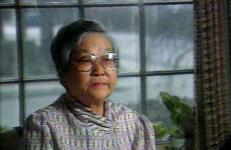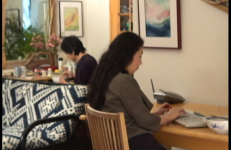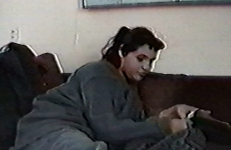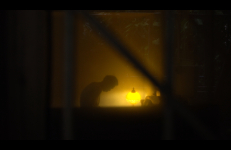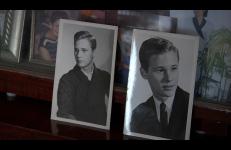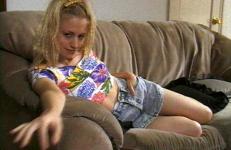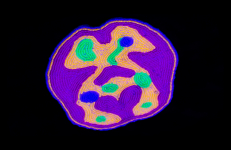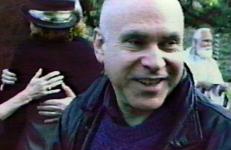Memory Palace is a short video grounded in the personal history of the artist. A discovery of a photo album activates memories of physical spaces, which in turn open doors to reminiscences of past family life. Inspired by the classical method of loci, the film presents a woman — singer/songwriter Alice Smith — at work in Los Angeles.
Family
Mom and Dad highlights causal conservations between Phil and his parents around family life, road trips, and camping in an interview-like setting, where his parents sit against a plain brick wall facing the cameras. Phil gives a live-demonstration of the image processor to his parents. His minimalistic approach to processing implies a laid back family time instead of his pursuit of an artful, finished product.
The artist's mother comments about the status of women while reading a doll house sized book titled Encyclopedia of Famous Women.
Segalove takes her mom as subject in these short pieces, recording her stories, her advice, and her daily routine. What results is a portrait of a contemporary mother-daughter relationship, touchingly devoid of drama and full of whimsical humor. For example, in one piece, Ilene’s mother laments over a pair of shoes her daughter has chosen to hang on the wall instead of wearing, saying,”With you, everything is art.” In another segment the camera focuses on a pair of unoccupied, overstuffed chairs.
Part bio, part memoir, Mom’s Move is an intergenerational film about mothers and daughters, women and photography, remembering and forgetting, and the tension between women’s private and public selves.
Rhoda Mogul, housewife and mother of six, was a lifelong avid amateur photographer. Her creative drive – though confined to the home – had a major influence on my public life as an artist and filmmaker.
Wendy Clarke's videos frequently feature unscripted dialogue, inviting speakers to create a video diary or to share their thoughts on a topic, such as love. This approach often results in sincere and honest portraits of the speakers. In Mother and Daughter Soap Opera, Wendy focuses her video diary on her relationship with her mother, Shirley Clarke. Both women set up a camera at their respective homes and recorded their end of a phone conversation between them: Wendy in New York City and Shirley in Los Angeles at the time.
Three insightful and funny vignettes highlighting Segalove's father's quirky traits, habits, and interests.
In this classic personal elegy, Kubota mourns her father's death and recounts the last days of his life. Reflecting on Kubota's use of the video medium, the television emerges as the link between Kubota and her father, with the melodramatic crooning of Japanese pop singers providing a backdrop for Kubota's real-life tragedy.
This title is also available on Surveying the First Decade: Volume 1.
Described by the New York Times as “an extraordinarily personal essay that struggles to explain and understand what went wrong in the director’s relationship with his father, Ray, a car dealer,” My Father Sold Studebakers is an auto-biographical work in which the artist reveals a wealth of familial relationships and problems. The tape is comprised of old home movies, family photographs, and candid interviews with the Sweeney family.
My Heart Belongs to Daddy is the third in a trilogy of experimental videos (Mad About the Boy and Can't Help Lovin' Dat Man). This third video uses text, archival movie footage, interviews and fantasy sequences to examine the correlation between the director's relationship with her "real" father and the search for "dyke-daddy." With cameo appearances from Rose Trouche, Robin Vachal, and Exum.
My mother's life and death were both extraordinarily epic. A painter who art therapized herself out of depression. Her resiliency could have rewarded her with a Badge of Courage; alchemizing trauma into art, activism and humor. Modeling these gifts for me, I look at our lives which could have been charted and copied page for page, letter by letter, and I recognize that I have imitated her style, not missing a beat.
— Linda Montano
My Mother Married Wilbur Stump is a video family album compiled by Skip Sweeney, a founder of San Francisco’s Video Free America, an alternative media facility. The video documents a discussion between the artist, his mother, and sister about their step-father, Wilbur Stump.
My Mother’s Place is an experimental documentary focusing on the artist’s mother, a third-generation Chinese-Trinidadian who at 80 still has vivid memories of a history lost or quickly disappearing. She conveys these with a storytelling style and a frankness that is distinctly West Indian. A tape about memory, oral history, and autobiography, My Mother’s Place interweaves interviews, personal narrative, home movies, and verité footage of the Caribbean to explore the formation of race, class, and gender under colonialism.
Eiko & Koma's second son Shin Otake created this video for the occasion of the 2004 American Dance Festival Scripps Award ceremony. Shin edited and narrated the video to convey Eiko & Koma's history and the concepts behind their works.
Two thoughtful young friends openly discuss their relationship with their sisters, both of whom are mentally challenged.
A portrait that follows Nan, my uncle who lives with his elderly parents, during the last two years that the three share the same house together. In long, tightly framed shots, a picture emerg-es of three intimately interwoven lives: the gentle and touching bickering between Nan and his mother, the evenings in front of the television when time seems to stand still, and the minutes ticking by as Grandpa silently peels an apple. It is a meditation on time, disabilities, and the economies of care. A warm and at times humorous ode to informal caregiving and the strength of family ties.
Nang has lived outside the box. Born in a Trinidadian village in 1934, she grew up poor, illegitimate, mixed-race and female, but she survived by defying convention. She left the first of five husbands when he cheated on her. With no formal training, she danced with choreographer Geoffrey Holder, who later won Tony Awards for The Wiz.
Nest of Tens is comprised of four alternating stories which reveal mundane yet personal methods of control. These systems are derived from intuitive sources. Children and a retarded adult operate control panels made out of paper, lists, monsters, and their own bodies.
Theo Cuthand and his mother Ruth Cuthand have a candid conversation about Theo's last hospitalization for Bipolar Disorder in 2007. While Theo only knew his manic episode from the inside, Ruth had to deal with caregiving decisions and trying to find help. While they reminisce they also have to reckon with the feelings of animosity that arose between them during these events.
Co-directed with Ruth Cuthand.
From childhood memories to recurring nightmares, Nine Fish attacks and illuminates the indecision and confusion surrounding euthanasia and care of the elderly in the United States. In this deeply spiritual and personal video, director Kip Fulbeck chronicles his Cantonese grandmother's physical decline and its continuing impact on his family. The shifting complexities of personal identity, family communication, and cultural assimilation are explored through nine semi-fictional stories.
Invoking a biblical story of life coming from dry bones, Condit constructs an experimental narrative about an older woman’s confrontation with her own mortality after the death of her mother. The bone represents the promise of youth and hope—a promise jealously coveted by the young, but needed more by those grown old. Inverting cultural values, Condit represents feminine youth as a mannequin, and seeks humanity in the form of the older woman, who is reborn by overcoming her fear of death.
Kuchar makes it to the Isis Oasis resort just in time to catch the marriage vows of his friends Rebecca and Steve. Transposing the myth of Isis in their union, Kuchar tries to make sense of this recreated paradise, this gathering of God’s creatures, and the fates of Rebecca von Hettman and Charlie Sheen—in this humid, steamy, stained story of the transmigration of souls.
This surreal, free-form autobiography is concerned with childhood and adult rituals, and the longing for meaning and connection during the often wildly absurd events of early life. Obsessive Becoming returns to Reeves’s early exploration of personal narrative forms, poetry, and his interest in creating a more spontaneous and direct fusion between language and video. Words and images of the expectations and disappointments of coming of age break down the boundaries of both mediums.
In Oh, Rapunzel, when Rapunzel flees the tower, Condit's mother leaves her home for an independent living facility and a freedom that she has never known. A collaboration between Cecelia Condit and Dick Blau. Music by Stephen Vogel. Re-edited in 2008.
This title is also available on Cecelia Condit Videoworks: Volume 1.
In Oh, Rapunzel, when Rapunzel flees the tower, Condit's mother leaves her home for an independent living facility and a freedom that she has never known. A collaboration between Cecelia Condit and Dick Blau. Music by Stephen Vogel. Re-edited in 2008.
This title is also available on Cecelia Condit Videoworks: Volume 1.




